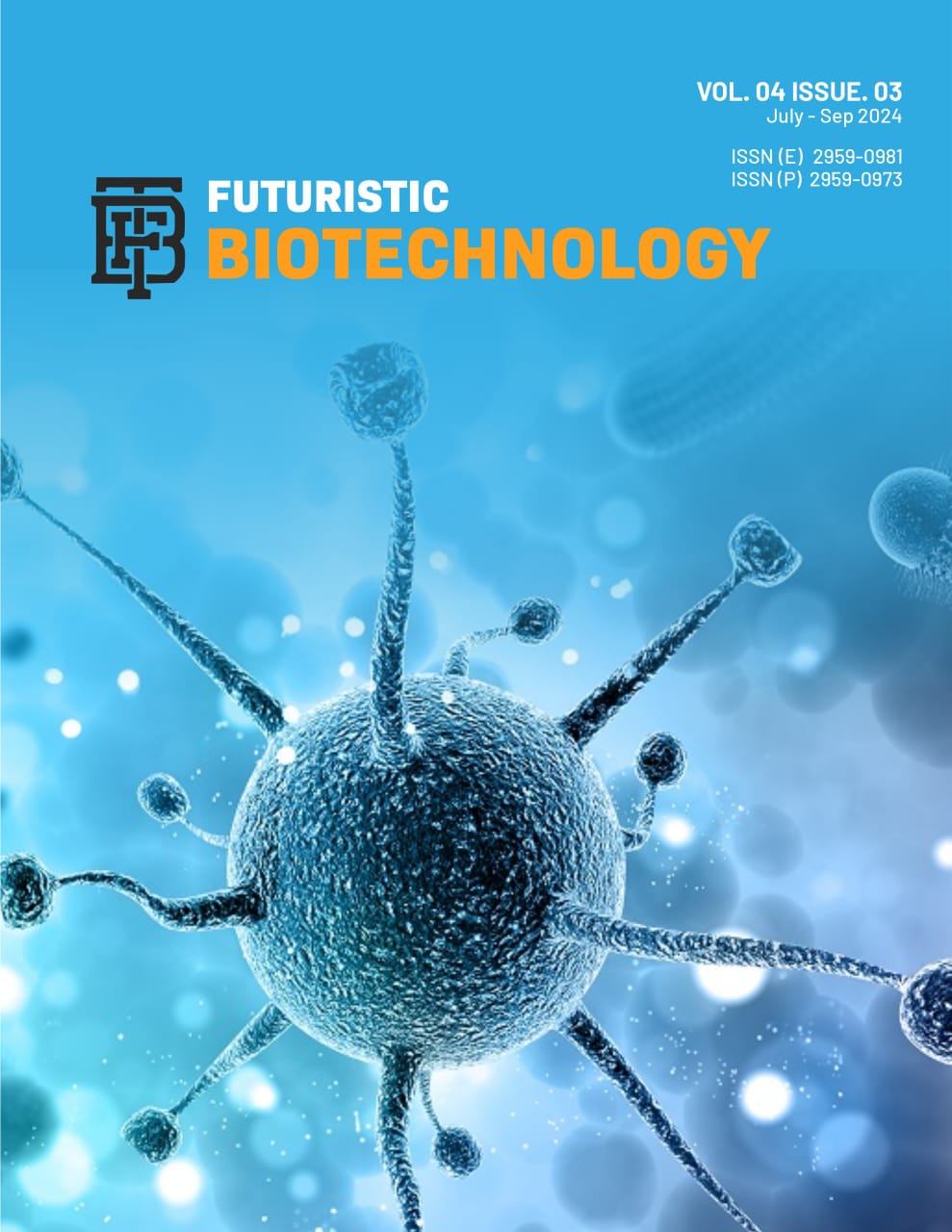Silver Nanoparticle–Integrated Nile Tilapia Skin Improves Healing of Skin Burn Wounds in Sprague Dawley Rats
Silver Nanoparticle–Integrated Nile Tilapia: Sprague Dawley Rats
DOI:
https://doi.org/10.54393/fbt.v4i03.205Keywords:
Tilapia Fish, Silver Nanoparticles, Burn, Wound Healing, CollagenAbstract
In developing nations, skin burns create a significant economic and medical burden, given the lack of proper infection control, which leads to high morbidity and mortality. Tilapia fish skin and silver nanoparticles (AgNPs) have strong antibacterial and healing-promoting abilities as a traditional biological dressing and as a potent biological dressing, respectively. Objectives: To measure the wound-healing ability of AgNP-modified Tilapia fish skin on second-degree burns in Sprague Dawley rats. Methods: A total of 20 male rats were categorized into four groups, namely Group 1 (normal skin), Group 2 (burn), Group 3 (burn treated with Tilapia fish skin), and Group 4 (burn treated with Tilapia fish skin conjugated with AgNPs). The method applied to induce the second-degree burns involved a heated metal block, and treatments were done after 24 hours. Day 21, histological and biochemical samples of the skin were taken, and they underwent ELISA and hydroxyproline assays. Results: The concentration of the hydroxyproline levels was raised significantly (375.67 ± 42.16 µg/mg) in comparison with Group II (96.00 ± 4.36 µg/mg). There was an increase in VEGF and SDF-1a, which means that angiogenesis and tissue repair were increased. Antioxidant parameters were found to restore GSH (0.272 ± 0.0157 µmol/mg) and normalize SOD and CAT activities, and they reduced MDA (0.024 ± 0.0026 nmol/mg). Liver, kidney, and heart histology were normal. Conclusions: AgNPs impaired tilapia fish skin enhances the healing of the burn wound through the increased production of collagen, angiogenesis, and the antioxidant response without causing systemic toxicity and making it a safe, cost-effective biological dressing.
References
Haruta A and Mandell SP. Assessment and Management of Acute Burn Injuries. Physical Medicine and Rehabilitation Clinics. 2023 Nov; 34(4): 701-16. doi: 10.1016/j.pmr.2023.06.019.
Fanstone R and Price P. Burn Contracture Risk Factors and Measurement in Low-Middle Income Countries: A Clinical Perspective. Burns. 2024 Mar; 50(2): 466-73. doi: 10.1016/j.burns.2023.09.007.
Ziauddin, Hussain T, Nazir A, Mahmood U, Hameed M, Ramakrishna S et al. Nano-engineered Therapeutic Scaffolds for Burn Wound Management. Current Pharmaceutical Biotechnology. 2022 Oct; 23(12): 1417-35. doi: 10.2174/1389201023666220329162910.
Júnior EM, De Moraes Filho MO, Costa BA, Fechine FV, Vale ML, De Loyola Diógenes AK et al. Nile Tilapia Fish Skin–Based Wound Dressing Improves Pain and Treatment-Related Costs of Superficial Partial-Thickness Burns: A Phase III Randomized Controlled Trial. Plastic and Reconstructive Surgery. 2021 May; 147(5): 1189-98. doi: 10.1097/PRS.0000000000007895.
Wali N, Wajid N, Shabbir A, Ali F, Shamim S, Abbas N et al. Safety Considerations for Lyophilized Human Amniotic Membrane Impregnated with Colistin and Silver Nanoparticles. Applied Biochemistry and Biotechnology. 2024 Mar; 196(3): 1419-34. doi: 10.1007/s12010-023-04618-3.
Francisco P, Neves Amaral M, Neves A, Ferreira-Gonçalves T, Viana AS, Catarino J et al. Pluronic® F127 Hydrogel Containing Silver Nanoparticles in Skin Burn Regeneration: An Experimental Approach from Fundamental to Translational Research. Gels. 2023 Mar; 9(3): 200. doi: 10.3390/gels9030200.
Bruna T, Maldonado-Bravo F, Jara P, Caro N. Silver Nanoparticles and Their Antibacterial Applications. International Journal of Molecular Sciences. 2021 Jul; 22(13): 7202. doi: 10.3390/ijms22137202.
Bold BE, Urnukhsaikhan E, Mishig-Ochir T. Biosynthesis of Silver Nanoparticles with Antibacterial, Antioxidant, Anti-Inflammatory Properties and Their Burn Wound Healing Efficacy. Frontiers in Chemistry. 2022 Aug; 10: 972534. doi: 10.3389/fchem.2022.972534.
Cheng L, Zhang S, Zhang Q, Gao W, Mu S, Wang B. Wound Healing Potential of Silver Nanoparticles from Hybanthus enneaspermus on Rats. Heliyon. 2024 Sep; 10(17). doi: 10.1016/j.heliyon.2024.e36118.
Adhikari SP, Paudel A, Sharma A, Thapa B, Khanal N, Shastri N et al. Development of Decellularized Fish Skin Scaffold Decorated with Biosynthesized Silver Nanoparticles for Accelerated Burn Wound Healing. International Journal of Biomaterials. 2023; 2023(1): 8541621. doi: 10.1155/2023/8541621.
American Veterinary Medical Association (AVMA). AVMA Guidelines for the Euthanasia of Animals. Schaumburg (IL): AVMA. 2020.
Orieshyna A, Puetzer JL, Amdursky N. Proton Transport Across Collagen Fibrils and Scaffolds: The Role of Hydroxyproline. Biomacromolecules. 2023 Sep; 24(11): 4653-62. doi: 10.1021/acs.biomac.3c00326.
Pudlarz AM, Czechowska E, S Karbownik M, Ranoszek-Soliwoda K, Tomaszewska E, Celichowski G et al. The Effect of Immobilized Antioxidant Enzymes on the Oxidative Stress in UV-Irradiated Rat Skin. Nanomedicine. 2020 Jan; 15(1): 23-39. doi: 10.2217/nnm-2019-0166.
Bustaman AL, Soekmadji PN, Sanjaya A. Nile Tilapia Skin in Burn Wound Healing: A Scoping Review. Burns. 2025 Apr: 107503. doi: 10.1016/j.burns.2025.107503.
Garrity C, Garcia-Rovetta C, Rivas I, Delatorre U, Wong A, Kültz D et al. Tilapia Fish Skin Treatment of Third-Degree Skin Burns in Murine Model. Journal of Functional Biomaterials. 2023 Oct; 14(10): 512. doi: 10.3390/jfb14100512.
Abdelnaby A, Assar DH, Salah A, Atiba A, El-Nokrashy AM, Elshafey AE et al. Extracted Marine Collagen from Nile Tilapia (Oreochromis niloticus l.) Skin Accelerates Burn Healing: Histopathological, Immunohistochemical and Gene Expression Analysis. Egyptian Journal of Veterinary Sciences. 2025 Jul; 56(8): 1849-65. doi: 10.21608/ejvs.2024.290709.2100.
Kaya M, Akdaşçi E, Eker F, Bechelany M, Karav S. Recent Advances of Silver Nanoparticles in Wound Healing: Evaluation of in Vivo and in Vitro Studies. International Journal of Molecular Sciences. 2025 Oct; 26(20): 9889. doi: 10.3390/ijms26209889.
Huang X, Liang P, Jiang B, Zhang P, Yu W, Duan M et al. Hyperbaric Oxygen Potentiates Diabetic Wound Healing by Promoting Fibroblast Cell Proliferation And Endothelial Cell Angiogenesis. Life sciences. 2020 Oct; 259: 118246. doi: 10.1016/j.lfs.2020.118246.
Barrera JA, Trotsyuk AA, Maan ZN, Bonham CA, Larson MR, Mittermiller PA et al. Adipose-Derived Stromal Cells Seeded in Pullulan-Collagen Hydrogels Improve Healing in Murine Burns. Tissue Engineering Part A. 2021 Jun; 27(11-12): 844-56. doi: 10.1089/ten.tea.2020.0320.
Tang D, Lin Q, Li PW, Wang S, Xu K, Huang YS et al. FG-4592 Combined with PRP Significantly Accelerates the Healing of Refractory Diabetic Wounds by Upregulating HIF-1α. Scientific Reports. 2025 Apr; 15(1): 14292. doi: 10.1038/s41598-025-99356-3.
Chen R, Xu H, Li X, Dong J, Wang S, Hao J et al. Role of Oxidative Stress in Post-Burn Wound Healing. Burns and Trauma. 2025 Jun: tkaf040. doi: 10.1093/burnst/tkaf040.
Moreno DA, Saladini MS, Viroel FJ, Dini MM, Pickler TB, Amaral Filho J et al. Are Silver Nanoparticles Useful for Treating Second-Degree Burns? An Experimental Study in Rats. Advanced Pharmaceutical Bulletin. 2020 Nov; 11(1): 130. doi: 10.34172/apb.2021.014.
Matysiak-Kucharek M, Sawicki K, Kapka-Skrzypczak L. Effect of Silver Nanoparticles on Cytotoxicity, Oxidative Stress and Pro-Inflammatory Proteins Profile in Lung Adenocarcinoma A549 Cells. Annals of Agricultural and Environmental Medicine. 2023; 30(3): 566-9. doi: 10.26444/aaem/169214.
You C, Li Q, Wang X, Wu P, Ho JK, Jin R et al. Silver Nanoparticle Loaded Collagen/Chitosan Scaffolds Promote Wound Healing Via Regulating Fibroblast Migration and Macrophage Activation. Scientific Reports. 2017 Sep; 7(1): 10489. doi: 10.1038/s41598-017-10481-0.
Downloads
Published
How to Cite
Issue
Section
License
Copyright (c) 2024 Futuristic Biotechnology

This work is licensed under a Creative Commons Attribution 4.0 International License.
This is an open-access journal and all the published articles / items are distributed under the terms of the Creative Commons Attribution License, which permits unrestricted use, distribution, and reproduction in any medium, provided the original author and source are credited. For comments editor@fbtjournal.com











